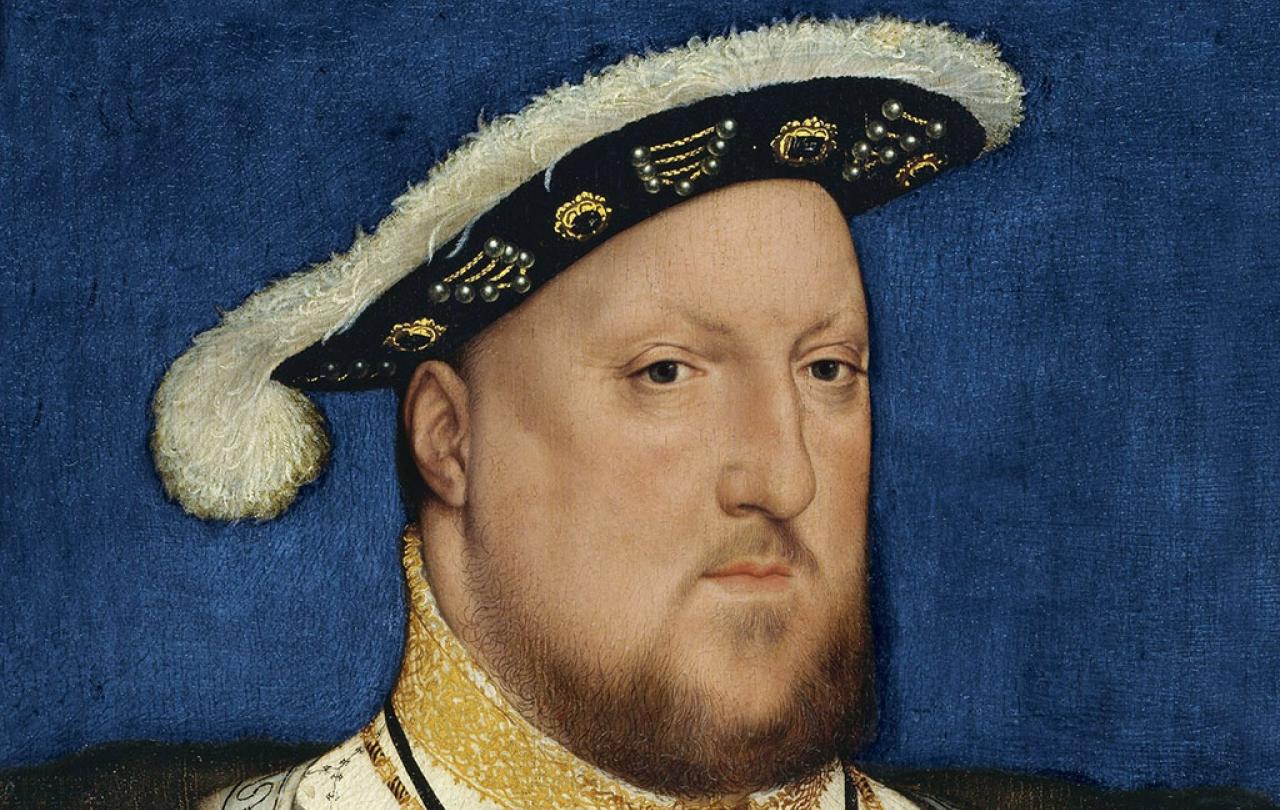
History offers many examples of toxic masculinity – perhaps none better than King Henry VIII. Two central qualities of Henry's inflated sense of manhood remain familiar today: he believed that he was always right, and he treated brutally those who disagreed.
The sixteenth century was a patriarchal age. Men dominated every position of power and influence, cultural values favoured men, and women were obsessively controlled. Wives had no existence under law; a husband had a legal right to dispose of his wife's property and money without her consent and knowledge. Women were barred from holding office, and were thought to be morally, mentally, and emotionally weaker than men. Despite (or perhaps because of) this, it was an age in which patriarchs were increasingly anxious and masculinity had to be repeatedly enacted.
In an age before credit checks, personal honour counted for everything. Honour was chiefly a measure of someone's ability to conform to gender ideals. For women, this meant chastity: celibacy before marriage and fidelity after it. Men could demonstrate honour in a range of ways. As a young man, Henry VIII showed his masculinity in displays of courage and strength on the tiltyard and at war. But, for men too, honour could be sexual. Men had to demonstrate an energetic sexual appetite.
1534. Henry wanted complicity even in his subjects' thoughts. The Treasons Act of the same year made it high treason to call the king a 'heretic, schismatic, tyrant, infidel or usurper of the crown'.
Henry VIII's blinkered patriarchal vision (and, to be fair, English history to that point) meant that, unlike Katherine his wife, Henry could not envisage their only surviving child, Mary, as a ruling queen. All their other children had died within a few hours, days or weeks of birth or had been born dead, and Katherine was in her forties. So, on grounds he knew were untrue – the suggestion that Katherine's marriage to his brother Arthur had been consummated – Henry sought one. The Pope refused – but Henry needed to be right. With a hefty dose of self-delusion, he used a partial reading of scripture to justify separating from his wife of twenty years. It took schism from the Roman Catholic Church to make it a reality.
The whole country was pulled into saying black was white. The Act of Succession of 1534 included an oath that every man (only men) was required to swear. They were to state that they regarded Mary 'but as a bastard' and that Anne Boleyn was Henry's lawful wife and the rightful Queen of England 'without any scrupulosity of conscience'. Henry wanted complicity even in his subjects' thoughts. The Treasons Act of the same year made it high treason to call the king a 'heretic, schismatic, tyrant, infidel or usurper of the crown'. Those who failed to agree with Henry's perspective – Sir Thomas More and Bishop John Fisher chief among them – were executed.
Part of the reason was that Henry became very attached to his position as Supreme Head of the Church. He reckoned himself a theologian. In 1536, he wrote the first doctrinal statement of the Church of England. Henry’s theological position, in the all-to-play-for years of the 1530s, was his own idiosyncratic hodge-podge of contemporary Catholicism and Protestantism. He hated Martin Luther’s idea that a person could be made right with God without having earned it, but he also denied the reality of purgatory (though he left funds for his own soul to be prayed for after death, just in case). Later in life the king would annotate religious texts composed by his bishops and be compared in his commissioned tapestries and psalter to the Old Testament patriarchs Abraham and David, and the New Testament saint Paul. He was depicted on the frontispiece of the Great Bible as first under God. A rebellion that sought to challenge his supremacy was put down with extreme force.
In other words, Henry’s preoccupation with preeminent masculinity can be seen even here: he thought his personal faith should determine the religious practice of the whole kingdom. Those who did not agree on a point of doctrine – like John Lambert, who held that the bread and wine of the Mass were symbols of, not literally, Christ’s body and blood – were executed. Henry personally presided over Lambert’s trial. On one day in 1540, on the king’s orders, three Protestants were burned as heretics, and three Catholics were hanged as traitors.
Anne's alleged adultery (the evidence for any actual adultery is risible) therefore profoundly affected Henry's perceived honour. For a king, the apparent lack of control or dominance in his household was especially galling.
This religious activity took place against a background of trials of Henry’s masculinity. Ultimately, the gamble of the break with Rome and marriage to Anne did not pay off. In fact, it exposed Henry to ridicule and dishonour.
After Anne had a baby girl and miscarried a boy, Henry became convinced that she was committing adultery and incest with five men including her brother. That one of Henry’s reasons for being attracted to Anne had been her intense personal engagement with faith should have indicated to him how unlikely these charges were to be true. In conversation she had mentioned that the king might one day die – which was also illegal under the Treasons Act – and so, in addition to adultery and incest, she was convicted of conspiring the king's death. But the trials backfired. Anne’s brother admitted at his that Anne had told him that Henry was 'not skillful in copulating with a woman and had neither vigour and potency'. This was said in front of a crowd of two thousand people in the Great Hall at the Tower of London.
Contemporary thought made a link between potency and fidelity. A woman's adultery was thought to be her husband's fault: The 1607 book, The court of good counsell, instructs a cuckolded man to 'find how the occasion came from himself, and that he hath not used her, as he ought to have done'. This was not an injunction to be kinder; in early modern parlance, 'use' was a euphemism for sex. Husbands needed to demonstrate sexual dominance, which was considered a crucial part of patriarchal control. In something called a charivari, men who were childless, thought to be ruled by their wives, or who cuckolded were mocked without mercy.
Anne's alleged adultery (the evidence for any actual adultery is risible) therefore profoundly affected Henry's perceived honour. For a king, the apparent lack of control or dominance in his household was especially galling.
A damaged sense of masculinity in a culture that insists on male dominance leads to doubling down.
It is for this reason that during the three short weeks between Anne's accusation and her execution, while she remained in the Tower, Henry visited Jane Seymour and danced with her late into the night. He remarried within eleven days of Anne's death. It was all to assert his sexual appetite – his manliness.
Henry's profound anxiety about his manhood also influences the picture we have of him. His most-copied, full-length portrait focuses on Henry not as a king – there is no crown, orb or sceptre – but as a man. In a martial stance, with broad shoulders and splayed feet, the king wears an enormously padded codpiece. Painted after Anne's death, it reeks of masculine bravado.
His toxic masculinity – as it has a habit of doing – replayed itself again and again. Henry had his marriage to Anne of Cleves (wife no. 4) dissolved on spurious grounds, but in fact because he was unable to consummate the marriage. He blamed his lack of arousal on her full breasts and large belly (which he took as indicators that she was not a virgin), insisting that wet dreams showed the problem was not with him. Meanwhile, wife no. 5, Kathryn Howard, was – history repeating itself – accused of adultery, raising once again the sense that Henry was unable to rule and reign.
A damaged sense of masculinity in a culture that insists on male dominance leads to doubling down. Both Anne Boleyn and Kathryn Howard were executed: one on the basis of concocted evidence, the other without a trial (an act of parliament declared Howard guilty). Henry VIII's reign is just one example of just how poisonous patriarchy can be.





